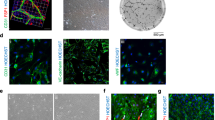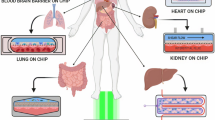Abstract
Real-time direct measures of hemostatic parameters in vivo are required for optimizing the dynamic delivery of coagulation modifying pharmacotherapies. Typical sensors of physiologic functions in vivo, however, have only a restricted array of sensory inputs, and thus limited capacity to monitor thrombotic and hemostatic activity. To overcome this limitation we have developed a genetically engineered excitable cell line that can be potentially used for an implantable thrombin biosensor. Specifically, we have generated stem cell-derived cardiac myocyte aggregates overexpressing the human thrombin receptor, protease activated receptor-1 (PAR-1), which exploit the inherent electropotential input–output relationship of the cells to detect local changes in thrombin activity. In vitro, the signaling activity of PAR-1 cardiac myocytes was highly responsive to thrombin, inducing a sixfold increase in intracellular cAMP as compared with a twofold increase in control cells. In vivo, the engineered myocytes also detected alterations in local coagulation potential. Specifically, PAR-1 engineered cells implanted in vivo detected local increases in thrombin with a doubling in chronotropic activity compared with a 50% increase in control aggregates. Overall these studies demonstrate the potential of genetic engineering to expand the physiologic signals recognized by excitable cells, and may facilitate the translation of this approach for the real-time monitoring of hemostatic function in vivo. © 2003 Biomedical Engineering Society.
PAC2003: 8239Fk, 8780Rb, 8719Hh, 8716Yc
Similar content being viewed by others
REFERENCES
Christini, D. J., K. M. Stein, S. M. Markowitz, and B. B. Lerman. Practical real-time computing system for biomedical experiment interface. Ann. Biomed. Eng.27:180–186, 1999.
Christini, D. J., J. Walden, and J. M. Edelberg. Direct biologically based biosensing of dynamic physiological function. Am. J. Physiol.280:H2006–H2010, 2001.
Coughlin, S. R.. How the proteosetnrombin talks to cells. Proc. Natl. Acad. Sci. USA96:11023–11027, 1999.
Denyer, M. C., M. Riehle, S. T. Britland, and A. Offenhauser. Preliminary study on the suitability of a pharmacological bioassay based on cardiac myocytes cultured over microfabricated microelectrode arrays. Med. Biol. Eng. Comput.36:638–644, 1998.
Drazner, M. H., K. C. Peppel, S. Dyer, A. O. Grant, W. J. Koch, and R. J. Lefkowitz. Potentiation of beta-adrenergic signaling by adenoviral-mediated gene transfer in adult rabbit ventricular myocytes. J. Clin. Invest.99:288–296, 1997.
Edelberg, J. M., W. C. Aird, and R. D. Rosenberg. Enhancement of murine cardiac chronotropy by the molecular transfer of the human beta2 adrenergic receptor cDNA. J. Clin. Invest.101:337–343, 1998.
Edelberg, J. M., J. T. Jacobson, D. S. Gidseg, L. Tang, and D. J. Christini. Enhanced myocyte-based biosensing of the blood-borne signals regulating chronotropy. J. Appl. Physiol.92:581–585, 2002.
Fromherz, P., A. Offenhausser, T. Vetter, and J. Weis. A neuron–silicon junction: A Retzius cell of the leech on an insulated-gate field-effect transistor. Science252:1290–1293, 1991.
Gross, G. W., B. K. Rhoades, H. M. Azzazy, and M. C. Wu. The use of neuronal networks on multielectrode arrays as biosensors. Biosens. Bioelectron.10:553–567, 1995.
Makino, S., K. Fukuda, S. Miyoshi, F. Konishi, H. Kodama, J. Pan, M. Sano, T. Takahashi, S. Hori, H. Abe, J. Hata, A. Umezawa, and S. Ogawa. Cardiomyocytes can be generated from marrow stromal cells. J. Clin. Invest.103:697–705, 1999.
Maltsev, V. A., J. Rohwedel, J. Hescheler, and A. M. Wobus. Embryonic stem cells differentiate into cardiomyocytes representing sinusnodal, atrial and ventricular cell types. Mech. Dev.44:41–50, 1993.
Sabri, A., G. Muske, H. Zhang, E. Pak, A. Darrow, P. Andrade-Gordon, and S. F. Steinberg. Signaling properties and functions of two distinct cardiomyocyte protease-activated receptors. Circ. Res.86:1054–1061, 2000.
Zaman, A. G., J. I. Osende, J. H. Chesebro, V. Fuster, A. Padurean, R. Gallo, S. G. Worthley, G. Helft, O. X. Rodriguez, J. T. Fallon, and J. J. Badimon. dynamic real-time monitoring and quantification of platelet-thrombus formation: Use of a local isotope detector. Arterioscler., Thromb., Vasc. Biol.20:860–865, 2000.-
Author information
Authors and Affiliations
Rights and permissions
About this article
Cite this article
Tang, L., Christini, D.J. & Edelberg, J.M. Genetically Engineered Biologically Based Hemostatic Bioassay. Annals of Biomedical Engineering 31, 159–162 (2003). https://doi.org/10.1114/1.1537693
Issue Date:
DOI: https://doi.org/10.1114/1.1537693




